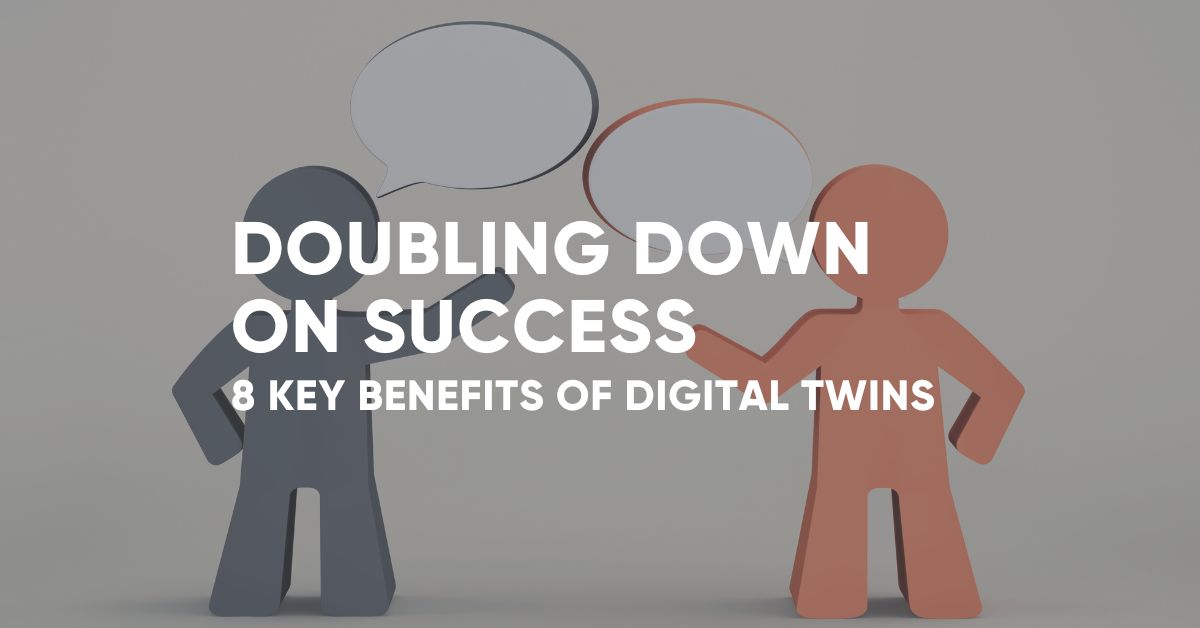In today’s fast-paced, data-driven world, businesses are constantly seeking innovative ways to optimize their operations, reduce costs, and enhance productivity. One groundbreaking technology that has gained significant traction in recent years is the concept of the “Digital Twin.” This technology promises to revolutionize industries across the board, from manufacturing and healthcare to urban planning and beyond.
In this article:
- What is a Digital Twin?
- 8 Benefits of Digital Twins
- Digital Twins in Action: 2 Examples of Use Cases
- Digital Twins in the Future
What is a Digital Twin?
At its core, a digital twin is a virtual replica or simulation of a physical object, process, system, or even an entire entity. It’s not just a static 3D model; it’s a dynamic representation that captures real-time data and behavior. Imagine it as a bridge between the physical and digital realms, where changes and events in the real world are mirrored in the virtual world, and vice versa.
Here’s a simplified breakdown of how it works:
- Data Collection: Sensors, IoT devices, and other data sources collect information about the physical object or system. This data can include temperature, pressure, location, movement, and much more.
- Digital Model: The collected data is used to create a digital model or “twin” of the physical entity. This model can be highly detailed, reflecting every nuance and aspect of the real-world counterpart.
- Real-time Updates: As new data is collected from the physical object, the digital twin is updated in real-time. This creates a continuous feedback loop between the physical and digital realms.
- Analysis and Prediction: Advanced analytics, machine learning, and AI algorithms can be applied to the digital twin to analyze data, make predictions, and simulate scenarios. This enables businesses to gain valuable insights and make informed decisions.
Benefits of Digital Twins for Businesses:
1. Improved Decision-Making: Digital twins provide businesses with a comprehensive understanding of their assets and operations. This enables data-driven decision-making, helping organizations make informed choices about maintenance, performance optimization, and resource allocation.
2. Enhanced Predictive Maintenance: In industries like manufacturing, energy, and aviation, digital twins enable predictive maintenance. By analyzing real-time data from machinery and equipment, businesses can identify when maintenance is needed before a breakdown occurs, reducing downtime and saving costs.
3. Increased Efficiency: Digital twins allow for the optimization of processes and workflows. By simulating different scenarios and making adjustments in the virtual world, businesses can find the most efficient ways to operate, resulting in cost savings and improved productivity.
4. Better Product Development: In product development, digital twins enable engineers and designers to test and refine prototypes virtually. This accelerates the development process, reduces the number of physical prototypes needed, and ensures products meet specifications and safety standards.
5. Sustainable Practices: Digital twins can help organizations reduce their environmental footprint. By modeling energy consumption, emissions, and resource usage, businesses can identify areas for improvement and implement sustainable practices.
6. Safer Operations: In industries like healthcare and construction, digital twins can be used to simulate and practice procedures in a risk-free environment. This enhances safety training and reduces the chances of accidents.
7. Urban Planning and Infrastructure: Cities can use digital twins to optimize urban planning, traffic management, and infrastructure development. This can lead to more efficient transportation systems, reduced congestion, and improved quality of life for residents.
8. Personalized Customer Experiences: In retail and e-commerce, digital twins can help create personalized shopping experiences. By analyzing customer data, businesses can tailor product recommendations and marketing strategies to individual preferences.
Digital Twins in Action
Siemens Gamesa Renewable Energy – Wind Turbine Optimization:
Siemens Gamesa, a leading manufacturer of wind turbines, has employed Digital Twins to optimize the performance and maintenance of their wind turbines. They create virtual replicas of each physical turbine, incorporating real-time data from sensors installed on the turbines in various locations. These Digital Twins simulate the turbines’ behavior, allowing engineers to monitor and analyze their performance remotely.
By using Digital Twins, Siemens Gamesa can predict potential issues, optimize maintenance schedules, and enhance overall operational efficiency. For instance, they can simulate different weather conditions and operational scenarios to predict wear and tear, enabling proactive maintenance to prevent downtime. This approach minimizes operational costs and downtime while maximizing energy production and asset lifespan. (source)
Coca-Cola – Bottling Line Efficiency:
Coca-Cola has leveraged Digital Twins to optimize the efficiency of its bottling lines. They create digital replicas of bottling lines that include all the components and machinery involved in the bottling process. These Digital Twins are fed with real-time data from sensors placed throughout the production line.
By analyzing the data and simulating different production scenarios, Coca-Cola can identify bottlenecks, optimize production flow, and predict maintenance needs. For example, if a specific machine’s performance deviates from the norm, the Digital Twin can predict when it might require maintenance, reducing the risk of unexpected breakdowns. (source)
Digital Twins in the Future
As technology continues to evolve, the potential applications of digital twins will expand. The integration of augmented reality (AR) and virtual reality (VR) will enable more immersive and interactive digital twins. Additionally, advancements in AI and machine learning will enhance the predictive and analytical capabilities of digital twins, making them even more indispensable to businesses.
Digital twins are not just a technological novelty; they are a powerful tool that can transform how businesses operate and make decisions. Organizations can optimize processes, reduce costs, improve safety, and ultimately gain a competitive edge in today’s data-driven economy by creating a virtual counterpart of the physical world. Embracing the concept of digital twins is not just an option; it’s a strategic imperative for businesses looking to thrive in the digital age.

